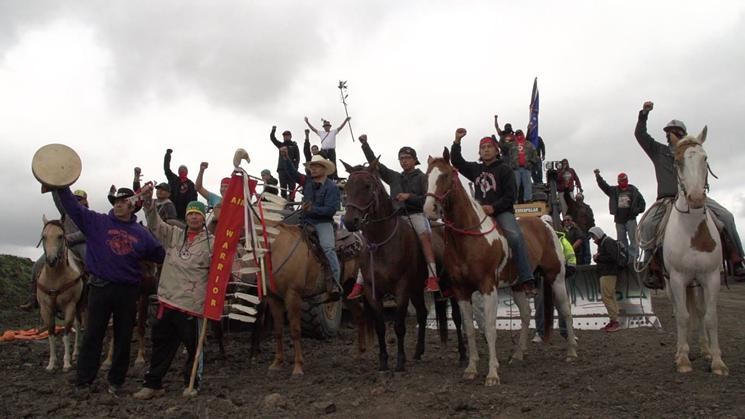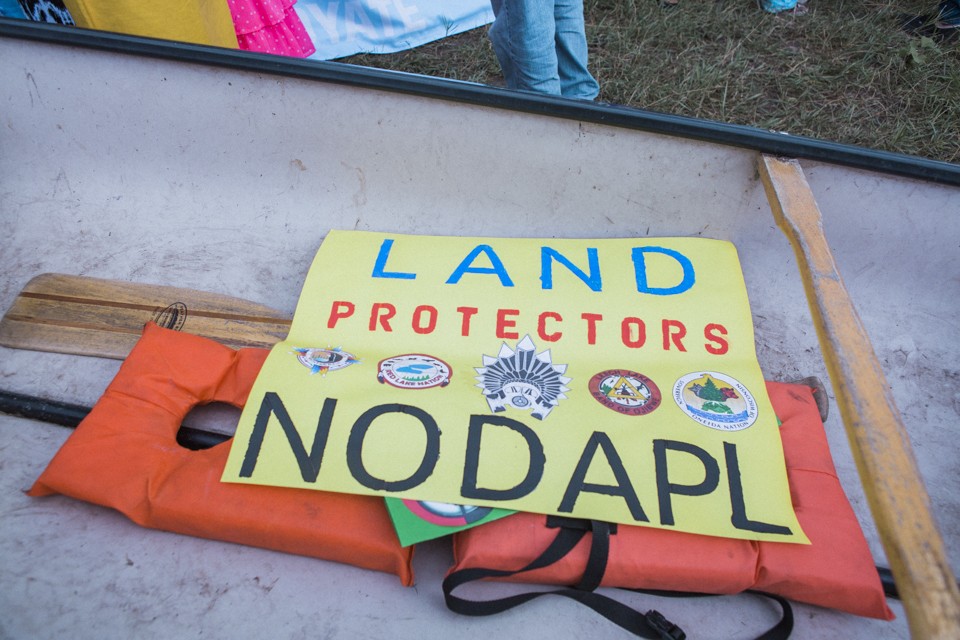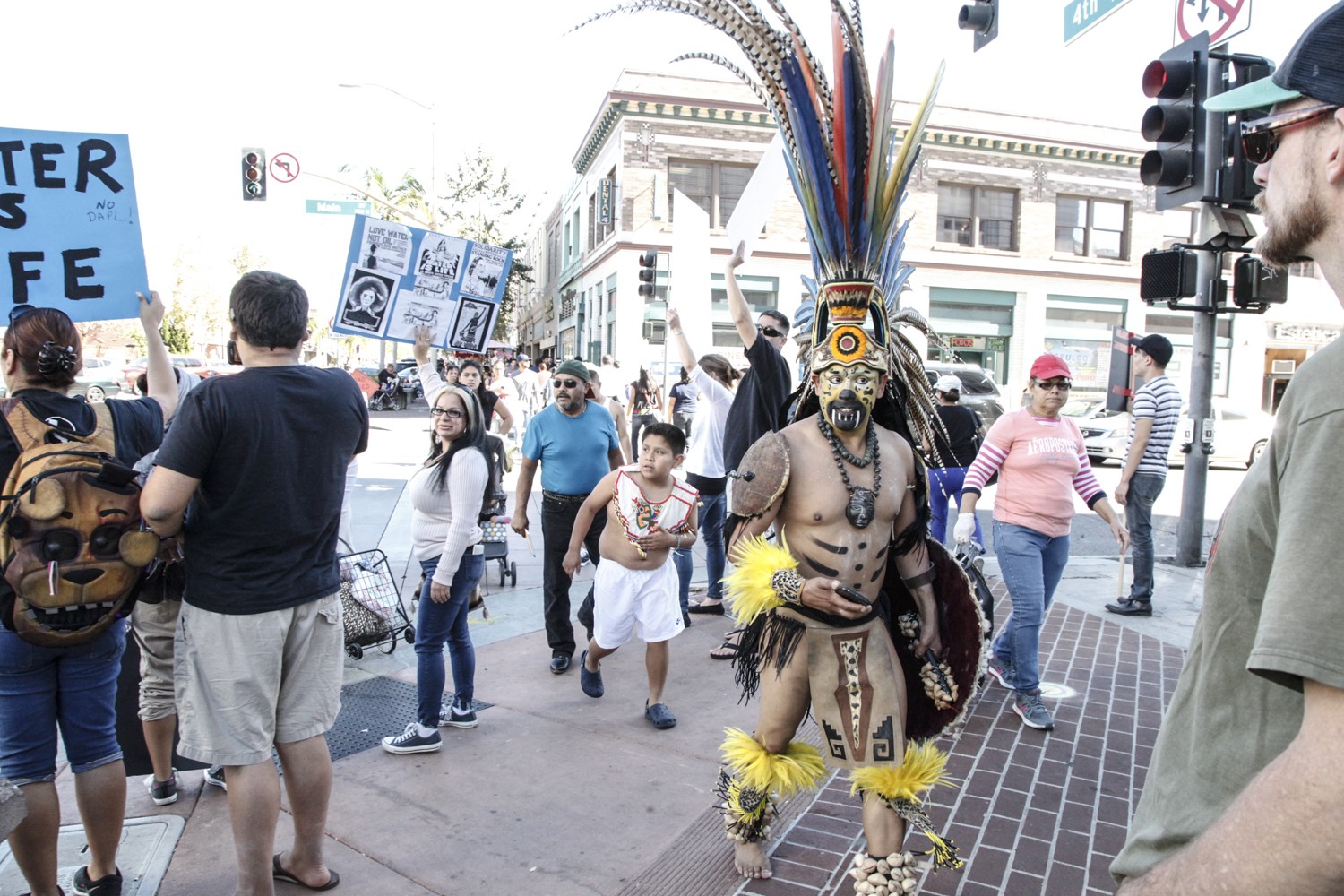 Eric Massimino of Huntington Beach hopped on a bus that took him and 40 other water protectors to an area of desolate highway in North Dakota where Energy Transfer Partners had begun lying pipe. They surrounded the machinery and prayed while they watched construction decimate an area of sacred land. Within 30 minutes, nearly 50 riot police bulldozed through the protectors, spraying mace from massive extinguishers. Massimino hustled back to the bus, when an older native was tackled and maced directly in the eyes. Unable to see or breath, law enforcement proceeded to beat the native while he was down.
Eric Massimino of Huntington Beach hopped on a bus that took him and 40 other water protectors to an area of desolate highway in North Dakota where Energy Transfer Partners had begun lying pipe. They surrounded the machinery and prayed while they watched construction decimate an area of sacred land. Within 30 minutes, nearly 50 riot police bulldozed through the protectors, spraying mace from massive extinguishers. Massimino hustled back to the bus, when an older native was tackled and maced directly in the eyes. Unable to see or breath, law enforcement proceeded to beat the native while he was down.
Meanwhile, Massimino and those who made it on the bus screamed and cried for help. The Morton County riot police surrounded the bus with clubs and other weaponry within a pocket's reach. Protectors scrambled to shut the bus windows, as they feared tear-gas. Uncertainty filled the bus. No one knew how long the cops would hold them hostage. People distributed food, believing they wouldn't eat for a couple days. Pens were passed around the bus for people to ink their skin with the legal number in case they went to jail. Santo Palo and sage were burned to cleanse the space, as an elder recited prayers.
“After an hour the police disbanded and let the bus leave, probably knowing what it would take to arrest all 40-something of us on the bus,” wrote Massimino in a journal entry, documenting the emotional experience.
The situation at Standing Rock hasn’t improved despite the easement denial of the Dakota Access Pipeline. Although many consider December 5th a day of victory, Massimino, protectors and natives warn that this is only the beginning. “The same day the easement was denied, Energy Transfer Partners released a statement basically disregarding everything Obama said,” Massimino says. “They have no intentions of removing the pipeline and no intentions of rerouting it—this is only temporary and the people here are aware of that.”

Surviving in sub-freezing temperatures, Massimino described the bleak conditions in North Dakota as the Wild West. The blizzards have ripped apart teepees, making people especially susceptible to hypothermia, pneumonia and injuries. During the interview, our cell phone connection cut in and out as he explained how devastating the weather has been to the community and morale.
With a reported four-fifths of the camp still hanging on—as opposed to the original 15,000 that once gathered on the reservation—Massimino said the energy on the grounds has shifted. Many who visited the reservation between April and early November described an aura of love that surrounded Standing Rock. But when you're left to survive outside in -20 degrees, it's hard to feel positive about anything.
The weather has thus brought a whole new set of challenges and dangers to the Standing Rock action. Law enforcement from surrounding towns have given stores, casinos and hotels strict instructions not to sell any propane or firewood, or cater to the people coming from Standing Rock. “The police know that if they use force to evict us, it’s going to cause an all-out war,” says Massimino. “They’re trying to weed us out by making it extremely difficult to survive.”
But it doesn't stop with propane and firewood. Morton County law enforcement have also shut down the bridge where a violent November 20th stand-off raged, in which 16 arrests were made while others were tear gassed, sprayed with freezing water and shot with rubber bullets. Closing the bridge means shutting off the most direct route for emergency services to get onto the reservation. Massimino pointed out that the Morton County police have made it impossible for the people at Standing Rock to get help. The only way protectors and/or residents can go to a hospital is if they’re taken by people who are staying at Standing Rock.
“I’ve recently had to take a few people to the hospital because of hypothermia and pneumonia,” said Massimino, with worry in his voice. “But I couldn’t just stay there with them. I had to drop them off, then go back to Standing Rock to help and then head back to the hospital for pick up later. We’re not being looked after anymore. And especially with the closed roads, like the front-line bridge, it’s clear what the police are trying to do.”

But trying to stay warm has created problems, too. Massimino journaled about a time playing cards huddled around a propane fire in the kitchen of his camp. The blizzard raged outside, as temperatures dropped to -40. A blood-curling scream— one that Massimino admits he'll never forget— pierced the blizzard winds. Massimino and his camp-mates were stunned to find the teepee full of people next to theirs in flames.
“A propane heater valve broke from inside and spewed fire everywhere,” Massimino writes. “The wind was blowing huge pieces of the canvas everywhere on fire, if the wind was going in any other direction our entire camp would've also been engulfed in flames. We ran around the teepee for 10 minutes fighting the fire, everyone inhaling smoke and chemicals from the extinguishers… If we hadn't heard those screams, or if that man didn't have a knife on him to cut [the teepee] open, the people inside would've died.”
Staying at Standing Rock puts Massimino at risk of being arrested and prosecuted as a domestic terrorist. Despite this, he doesn't know when he'll return to Orange County. “Someone from security who was apart of [my] camp brought unbelievable news” he journaled. “Five natives from the November 20th stand are being targeted for domestic terrorism… The reality of the situation [i]s that all of us at Standing Rock are at risk of getting that classification. To make it clear, this is how our government wants to classify us…”
Anthony Diggs, a San Clemente-based musician, arrived home from Standing Rock last Saturday. Gathering 2,100 veterans by way of Facebook, Diggs along with four other people organized a massive group to support and stand with the water protectors on the reservation. “We thought we were going to have 100 maybe 200 people,” says Diggs. “We were blown away when we capped out the roster at 2,100 people. Veterans who served in Vietnam, Iraq and Afghanistan were a part of our group. Men and women who served of all ages joined us. Some hadn't served in the military in years, while others had just gotten out.”

When they arrived to Standing Rock on November 4th, over 4,000 veterans were there— 2,100 of whom were a part of Diggs group. Within a day of being there, the easement denial announcement surfaced. “Our welcoming ceremony was also the forgiveness ceremony, which became a kind of celebratory thing that day” says Diggs. “It was one of the most beautiful things I've ever seen. Although in many ways history is repeating itself at Standing Rock, the forgiveness displayed by the natives is a reminder of how powerful love is.”
Within hours of the ceremony, a massive blizzard rolled in. The goal, according to Diggs, was to make sure everyone in his group was safe and had what they needed, which is no small feat with 2,100 people. But the Standing Rock reservation donated gymnasiums to house the veterans, at least allowing for solid shelter. Making sure everyone stayed warm and fed was a mission, however.
Diggs and the group of organizers rented trucks and busses in order to transport people and supplies. The blizzard quickly revealed that help was needed all over the reservation. “Our time out there became a help, rescue and evacuate mission,” he says. “There are tons of people with hypothermia right now because police are blocking the roads needed in order to get people medical attention. It's a big mess. They need ways to stay warm, which is close to impossible right now even if you have the best winter gear on the market. There's honestly no way you can prepare for those kinds of conditions. Peoples' teepees were getting destroyed, tents were flying away. It was madness. People are getting really sick.”
Zen and Todd Honeycutt and their three sons traveled to Standing Rock in mid-November. While the boys spent the days chopping wood to help build yurts, Zen experienced the violence on November 20th first-hand. She saw multiple rubber-bullet head-wounds and a woman who'll likely have her arm amputated after reportedly being hit by an officer's concussion grenade. Zen was also one of hundreds of people who got tear-gassed that night, too. “It was horrible, but I was so impressed by the protesters,” she says. “They'd get tear-gassed, wash their eyes with milk of magnesia and within 30 or 40 minutes went right back out there… It was a humbling and disturbing experience. I say humbling because you're faced with the question of 'are you willing to die or severely suffer for this?' It really makes you think about what you would do for your children.”
Gene Stone, a 70-year-old environmentalist from San Clemente, dropped all of his plans to show his support at Standing Rock. Stone's grandmother was a member of the Cheyenne tribe native to Montana and Oklahoma. Stone's pride lies in his native blood, which inspired him to road trip alone to North Dakota. He arrived to the reservation several weeks prior to the veteran surge. But as a Vietnam war vet, he was moved by the repentance and forgiveness exercised by the veterans and natives. “We've come a long way,” says Stone. “What it shows me is that although we join to serve and protect our country, we are able to see that our country oftentimes does not do the right thing.”
But Stone's mostly concerned about the President-elect's impact on the Dakota Access Pipeline. Not only has Trump invested money in Energy Transfer Partners, the team he's built around him haven't the slightest concern for Earth preservation. “Now that someone is taking over the presidency who's built a group of fascists who don't believe in climate change, it's very crucial to be aware of the oneness with all parts of creation. That's is why this movement is so important. We are supposed to be the caretakers of this planet.”
The Dakota Access Pipeline is yet another example of colonialism's 500-year reign. But the natives and protectors at Standing Rock won't concede. “The most important thing is for people not to forget that Standing Rock is still happening— it can't get swept under the rug,” says Massimino. “The best way for people to help is by praying or donating things like winter survival clothes and gear, firewood and propane. No one is leaving until the pipeline is gone and all of the equipment is taken down…This is the revolution.”


